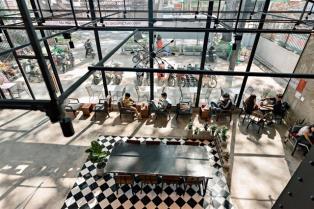Thailand's Beri Juker Public Co. Ltd (BJC) signed a deal earlier this month to buy the Viet Nam operations of Germany wholesaler Metro for US$876 million.
 |
| Metro, which came to the country in 2002 and has 3,600 employees nation-wide, reported revenues of $692 million in 2012-13.— Photo nld.com.vn |
Compiled
Thailand's Beri Juker Public Co. Ltd (BJC) signed a deal earlier this month to buy the Viet Nam operations of Germany wholesaler Metro for US$876 million.
Metro, which came to the country in 2002 and has 3,600 employees nation-wide, reported revenues of $692 million in 2012-13.
Analysts said the acquisition marks the Thai giant's aggressive expansion into Viet Nam's retail sector.
Last year BJC, owned by billionaire Aswin Techajaroenvikul, had bought convenience store chain Family Mart, which had 421 outlets, together with Viet Nam's Phu Thai Group.
They have now opened scores of B's mart outlets around the country.
The company also holds a 65 per cent stake in Thai An Joint Stock Company, a distribution and logistics firm with interests in food and non-food products, which has a presence in 63 cities and provinces and a network of 200 sub-distributors, 2,500 wholesalers, and thousands of retailers in traditional markets.
Thailand-based CP Group has been ruling the roost in the Vietnamese foodstuff and animal feed markets for several years now.
A source said that BJC had planned to spend only $500 million to buy Metro but decided to shell out the additional $300 million after the Germans held out for more.
The Thai giant not only eyes the potentially huge Vietnamese retail market, but also hopes to take advantage of the ASEAN Economic Community due to come into existence next year when intra-bloc tariffs will be cut to zero.
The question is will the Thai firms' entry into the retail market affect Vietnamese producers and retailers?
Analysts said the Vietnamese goods that are being sold at big supermarket systems such as Metro and Big C now are significant figures. So more and more urban residents want to shop at such places, meaning Vietnamese goods are likely to be increasingly popular at these places.
However, if more and more Thai firms enter the organised retail market, products from their country will vie for the same shelf spaces and surely have an impact on Vietnamese goods. Most Thai products are of good quality and come in a range of designs, and their prices are not much higher than that of similar Vietnamese products.
Besides, because of the support Thai producers and exporters extend to them, importers, distributors and retailers of Thai products in Viet Nam are always ready to sell them.
According to the General Statistics Office, in the first half of the year Viet Nam ran up a trade deficit of $1.37 billion with Thailand, most of which came from imports of consumer goods.
In the event, some experts warn of the possibility that Vietnamese consumer goods would be unable to compete with their Thai counterparts. But others dismiss the fears, saying "there is not cause for much concern".
The number of Vietnamese consumers preferring Thai products has fallen significantly in recent years as evidenced by the lack of crowds these days at shops selling Thai goods at border gates.
The percentage of Thai consumer goods sold in the southern provinces at wholesale markets like Binh Tay is also very small.
This change has come about because Vietnamese consumer goods have become more competitive with better quality, finer designs, and cheaper prices.
Analysts said however that producers and distributors should quickly alter their business methods to focus on the quality of products, set up flexible distribution systems, and offer incentives to retailers if they want to compete with their Thai rivals.
Retailers should co-operate with each other to retain market share and encourage consumers to use Vietnamese goods, they suggested.
High risk, high return
Many banks are trying to increase consumer loans to push up credit growth despite knowing the high risks attached to them.
Ernst and Young Viet Nam said in a recent report that the banking sector has been very successful in the retail banking segment, particularly consumer lending, which refers to credit extended to non-commercial customers for something besides a home purchase.
This is understandable in a market with a population of over 90 million and no reluctance to spend. Indeed, young Vietnamese, unlike the older generations, are ready to borrow for spending.
Consumer credit grew by 12 per cent last year even as other credit segments were almost frozen.
Now interest rates on consumer loans at most banks are at 14-15 per cent if the borrower brings in collateral. The rate can go up to 30-36 per cent without security.
This has attracted many banks who hope to increase profits and also their credit growth. The State Bank of Viet Nam has set the credit growth target for this year at 12 per cent while the industry achieved only 3.68 per cent in the first seven months.
To enable increased consumer lending, banks have been exploring the option of acquiring finance companies, which enjoy certain advantages over lenders. For instance, finance companies often do not require collateral from borrowers, and their lending procedures are very simple. They often made loan disbursements in a matter of minutes.
These conditions are ideal for middle- and low-income earners, who account for a majority of the population, to borrow.
As a result, financial companies have achieved much success in consumer lending.
The Netherlands-owned Home Credit, for instance, has been in the Vietnamese market for only seven years, but has raked in profits through personal lending.
In the first half of this year the company made a profit of over $20 million from consumer loans and hopes to double that in the full year. Its profitability ratio is thought to be over 20 per cent.
To develop consumer lending, the Viet Nam Maritime Commercial Joint Stock Bank (Maritime Bank) recently bought a 64.1 per cent stake in the Viet Nam Textile and Garment Finance Company.
VPBank has completed the acquisition of Vinacomin Finance Company, while Petrovietnam Finance Corporation has merged with Western bank to become the Viet Nam Public Joint Stock Commercial Bank.
But the high profitability comes at a price, analysts warned: the big risk of bad debts.
Because consumer loans mostly do not require collateral and borrowers' antecedents are only checked cursorily, there is a big chance that lending banks would lose their money.
Often borrowers have to pay interest rates of 6-7 per cent per month compared to only 3-5 per cent per month if they buy on hire purchase.
Analysts explained that financial institutions have to charge such high interest rates on consumer loans because they are only allowed to mobilise deposits for a maximum of 12 months, meaning they have to pay high interest rates for depositors .
Besides, they also have to cover the losses made because of lack of collateral.
According to figures from the central bank, last year the bad debts of finance companies and financial leasing companies stood at 21.96 per cent and 37.53 per cent. — VNS





